From the Trenches
History in the DNA
By JARRETT A. LOBELL
Monday, June 10, 2019
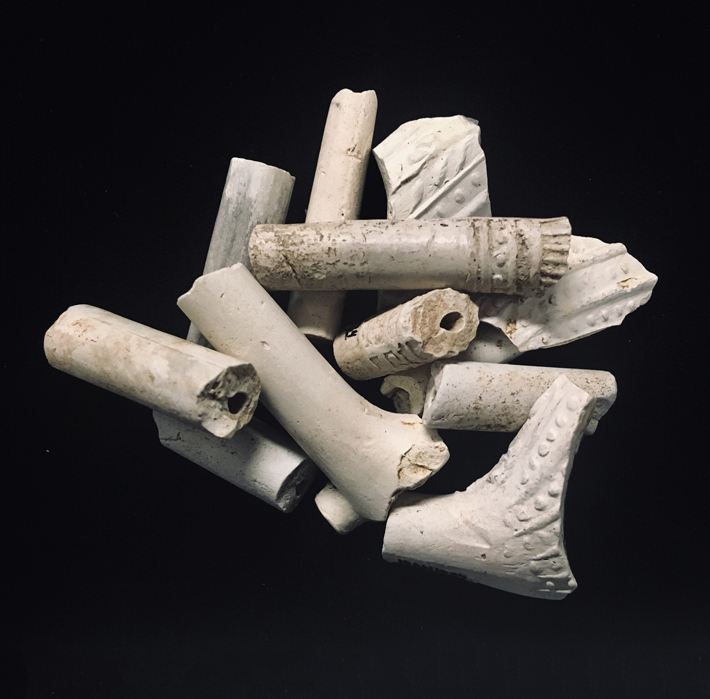 An early nineteenth-century clay pipestem, one of many unearthed in the slave quarters at the former Belvoir tobacco plantation on Maryland’s Chesapeake Bay, has allowed archaeologists to rescue a lost history. DNA yielded by the seemingly unremarkable artifact has enabled them to determine that the pipe was used by a woman closely related to the Mende people of present-day Sierra Leone. This is a new way to connect an individual to an artifact she once used, says Julie Schablitsky, project director and chief archaeologist with the Maryland Department of Transportation. “You have this small, common object, and all of sudden this new world opens up and there is a whole person behind it,” she says. “It starts to take us back to the beginning, back to West Africa, where her story began.”
An early nineteenth-century clay pipestem, one of many unearthed in the slave quarters at the former Belvoir tobacco plantation on Maryland’s Chesapeake Bay, has allowed archaeologists to rescue a lost history. DNA yielded by the seemingly unremarkable artifact has enabled them to determine that the pipe was used by a woman closely related to the Mende people of present-day Sierra Leone. This is a new way to connect an individual to an artifact she once used, says Julie Schablitsky, project director and chief archaeologist with the Maryland Department of Transportation. “You have this small, common object, and all of sudden this new world opens up and there is a whole person behind it,” she says. “It starts to take us back to the beginning, back to West Africa, where her story began.”
The ability to find such stories is vital to descendants of enslaved people hungry for information about their families’ pasts, especially in the absence of manumission records, wills, or possessions. “The descendants ask me, ‘Can you connect me to this space? Can you say that my ancestors were here?’” says Schablitsky. “It’s so hard to learn anything personal about these enslaved people, but information about gender and place of origin such as we learned from the pipestem provides a kind of personal validation for their descendants. It allows to them to say, ‘We survived.’”
A Funeral Fit for Etruscans
By BENJAMIN LEONARD
Monday, June 10, 2019
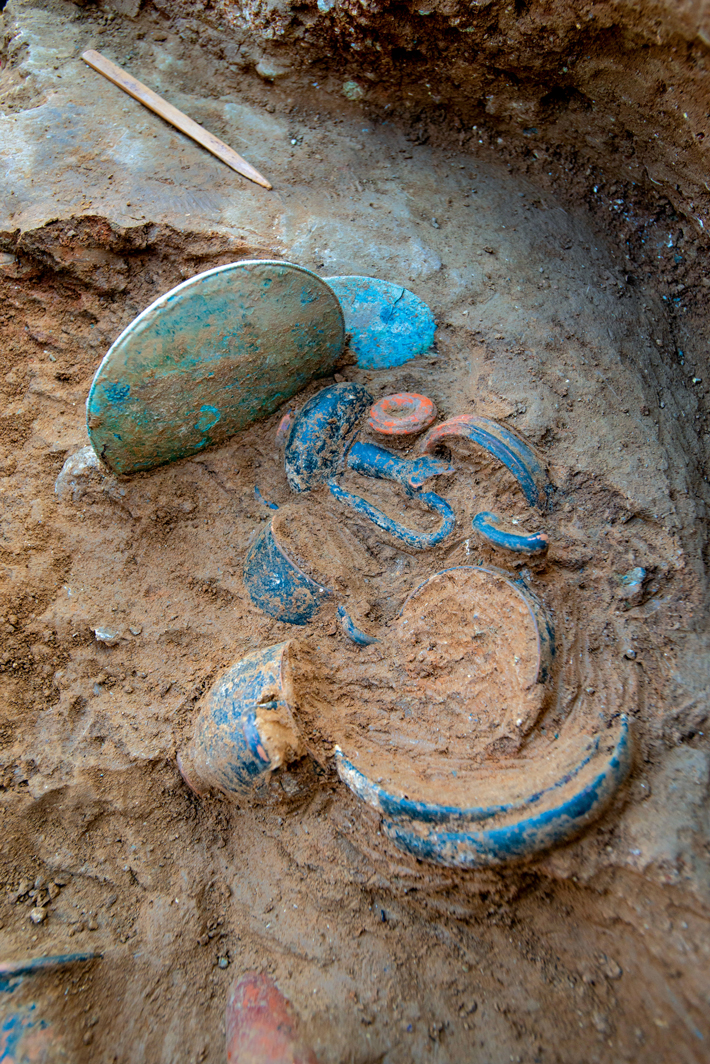 The discovery of a fourth-century B.C. Etruscan burial in Aleria, on Corsica, has yielded new details of the pre-Roman culture’s funerary practices. While excavating hundreds of graves dating from the third century B.C. through the third century A.D. in a Roman necropolis on the island’s eastern side, archaeologists from France’s National Institute of Preventive Archaeological Research (INRAP) found stairs descending to a long corridor and a hypogeum—a rock-cut underground burial chamber normally reserved for high-status individuals—predating the Roman burials. More than 100 tombs of this type were excavated in the 1970s and 1980s at Casabianda, another Etruscan cemetery just to the south.
The discovery of a fourth-century B.C. Etruscan burial in Aleria, on Corsica, has yielded new details of the pre-Roman culture’s funerary practices. While excavating hundreds of graves dating from the third century B.C. through the third century A.D. in a Roman necropolis on the island’s eastern side, archaeologists from France’s National Institute of Preventive Archaeological Research (INRAP) found stairs descending to a long corridor and a hypogeum—a rock-cut underground burial chamber normally reserved for high-status individuals—predating the Roman burials. More than 100 tombs of this type were excavated in the 1970s and 1980s at Casabianda, another Etruscan cemetery just to the south.
Sealed shut by clay, rocks, charcoal, and pieces of pottery, the intact tomb contained a skeleton surrounded by collapsed ceremonial furniture, a mirror, and various drinking vessels. “This discovery allows us to understand the internal arrangement of the burial,” says INRAP archaeologist Catherine Rigeade. She explains that there are likely other contemporaneous burials at the site, which would provide additional evidence for an ongoing Etruscan presence on Corsica prior to the Roman conquest of the island in 259 B.C.
Off the Grid
By MARLEY BROWN
Monday, June 10, 2019
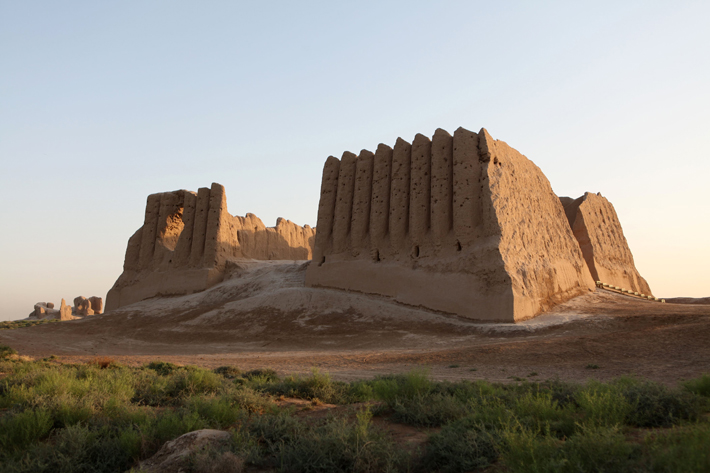 Over many centuries, a settlement on an oasis along the Silk Road grew into one of the world’s great metropolises. Ancient Merv was a nexus of commercial goods, languages, ideas, and religious beliefs connecting Europe, Africa, and the Far East. The site was first settled in the fifth century B.C. by the Achaemenids, whose empire stretched from the Caucasus to Egypt. Their settlement, Erk Kala, was succeeded by Gyaur Kala, which was built by Greek Seleucids under Antiochus I (r. 281–261 B.C.). Over the next millennium, Merv became a major economic and political center for a succession of empires. By the eighth century A.D., the Islamic Abbasid Caliphate had established Merv as their eastern capital. They called it Sultan Kala and turned it into one of the world’s largest urban centers. In the late Middle Ages, maritime trade gradually supplanted the traditional land routes of the Silk Road, and Merv began a slow decline. The city was devastated by a Mongol attack in 1221, a blow from which it never really recovered.
Over many centuries, a settlement on an oasis along the Silk Road grew into one of the world’s great metropolises. Ancient Merv was a nexus of commercial goods, languages, ideas, and religious beliefs connecting Europe, Africa, and the Far East. The site was first settled in the fifth century B.C. by the Achaemenids, whose empire stretched from the Caucasus to Egypt. Their settlement, Erk Kala, was succeeded by Gyaur Kala, which was built by Greek Seleucids under Antiochus I (r. 281–261 B.C.). Over the next millennium, Merv became a major economic and political center for a succession of empires. By the eighth century A.D., the Islamic Abbasid Caliphate had established Merv as their eastern capital. They called it Sultan Kala and turned it into one of the world’s largest urban centers. In the late Middle Ages, maritime trade gradually supplanted the traditional land routes of the Silk Road, and Merv began a slow decline. The city was devastated by a Mongol attack in 1221, a blow from which it never really recovered.
Virtually all the material dating to the Erk Kala and early Gyaur Kala periods is buried up to 60 feet under the surface. “Realistically, with our attention to modern stratigraphic excavation, the time needed for such a deep excavation—even if the health and safety issues could be overcome—would make it very difficult to undertake,” explains Tim Williams, director of University College London’s Ancient Merv Project. However, researchers have used aerial photography to capture the entire site, particularly the remains of the medieval city of Sultan Kala. Says Williams, “It’s enabled us to understand the layout of the city, down to the detail of individual houses and buildings, in a way that a surface survey could never do.”
THE SITE
Visiting Turkmenistan requires advance planning, and travelers are encouraged to sign up with one of the international tour groups leading trips to Merv. Before you travel to the site, Williams recommends a visit to the national museum in the capital, Ashgabat, for an overview of the history of the region, and to the museum in Mary, the nearest city to Merv, which houses artifacts uncovered at the site. In addition to ruins of fortifications dating to the Erk Kala and Gyaur Kala periods, visitors will see the remains of impressive medieval earthen buildings called koshks. The largest of these, the Great Kyz Kala, lies just outside Sultan Kala’s western wall, and was likely built between the eighth and the ninth centuries as a fortified palace.
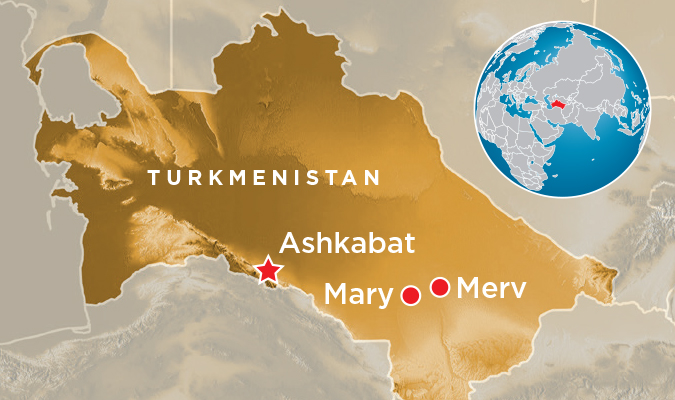 WHILE YOU’RE THERE
WHILE YOU’RE THERE
Take a day trip out to the site of the Parthian city of Nisa, which was occupied from roughly the third century B.C. to the third century A.D. Continue your immersion in the past by booking a tour to ride the famous Turkmen horses in the foothills of Kopet Dag, the breathtaking mountain range that separates Turkmenistan and Iran.
Snake Snack
By ERIC A. POWELL
Monday, June 10, 2019
 Some 1,500 years ago, a hunter-gatherer in the canyon lands of the Lower Pecos region of southwest Texas made the unfathomable decision to gulp down a whole snake, fangs and all. Texas A&M University archaeologist Elanor Sonderman discovered evidence for this queasy-making culinary event while studying a human coprolite, or desiccated feces, that was excavated in the 1960s at the site of Conejo Shelter. While examining the coprolite, which contained the expected plant remains, Sonderman found a fang, as well as scales and bones, belonging to a venomous snake—either a copperhead or a rattlesnake.
Some 1,500 years ago, a hunter-gatherer in the canyon lands of the Lower Pecos region of southwest Texas made the unfathomable decision to gulp down a whole snake, fangs and all. Texas A&M University archaeologist Elanor Sonderman discovered evidence for this queasy-making culinary event while studying a human coprolite, or desiccated feces, that was excavated in the 1960s at the site of Conejo Shelter. While examining the coprolite, which contained the expected plant remains, Sonderman found a fang, as well as scales and bones, belonging to a venomous snake—either a copperhead or a rattlesnake.
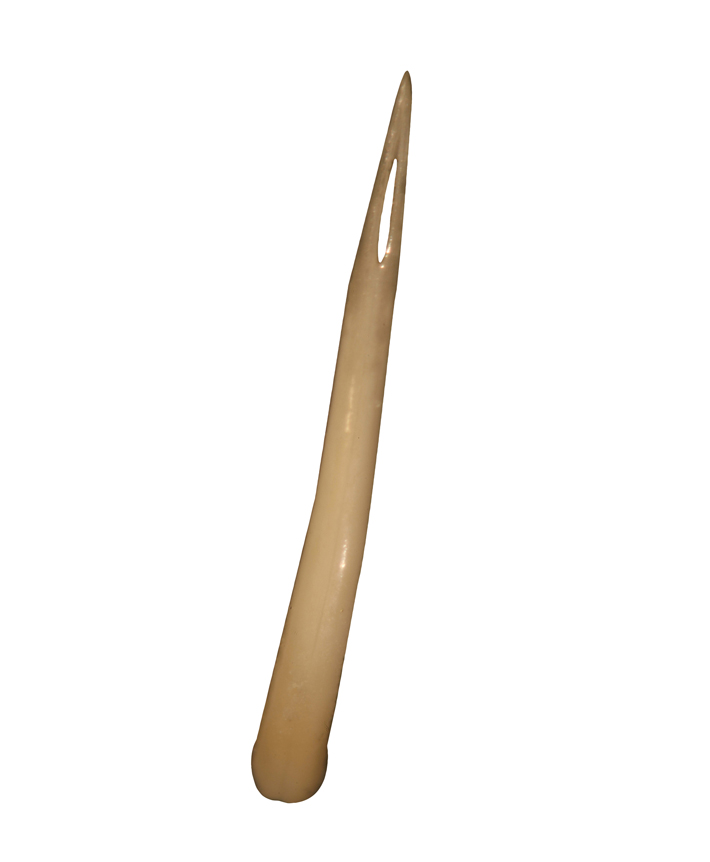 Other coprolites from the area show that people did, occasionally, eat snakes at the time, but only after dressing and cooking them. The bones in this case showed no signs that the reptile had been prepped. Rather, the adventurous gourmand probably ingested the creature without first defanging or descaling it. “It’s possible someone was curious and looked at a snake and said, ‘I will put that in my mouth,’” says Sonderman, “but it’s not likely.” She points out that serpentine figures are often depicted in rock art of the Lower Pecos, suggesting that snakes were important symbolically. It’s possible that consumption of the snake was an element of a ritual, likely undertaken by someone with an uncommonly strong stomach.
Other coprolites from the area show that people did, occasionally, eat snakes at the time, but only after dressing and cooking them. The bones in this case showed no signs that the reptile had been prepped. Rather, the adventurous gourmand probably ingested the creature without first defanging or descaling it. “It’s possible someone was curious and looked at a snake and said, ‘I will put that in my mouth,’” says Sonderman, “but it’s not likely.” She points out that serpentine figures are often depicted in rock art of the Lower Pecos, suggesting that snakes were important symbolically. It’s possible that consumption of the snake was an element of a ritual, likely undertaken by someone with an uncommonly strong stomach.
You Say What You Eat
By LYDIA PYNE
Monday, June 10, 2019
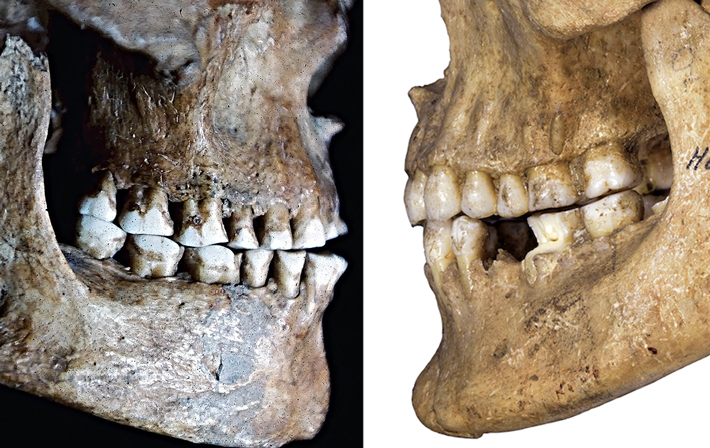 Try saying “f” and “v” and pay close attention to your lower lip and upper teeth. Would it surprise you to learn that these sounds are relatively recent additions to human languages? Languages, of course, develop over time as usage, meaning, and pronunciation change. But what about the ways our bodies have changed over the millennia? Could this also contribute to changes in language? In a new study, researchers from the Max Planck Institute for the Science of Human History and the University of Zurich have used evidence from paleoanthropology, speech biomechanics, ethnography, and historical linguistics to determine that, in fact, it is a combination of factors—both cultural and biological—that produces changes in language and has contributed to the diversity of languages that exist today.
Try saying “f” and “v” and pay close attention to your lower lip and upper teeth. Would it surprise you to learn that these sounds are relatively recent additions to human languages? Languages, of course, develop over time as usage, meaning, and pronunciation change. But what about the ways our bodies have changed over the millennia? Could this also contribute to changes in language? In a new study, researchers from the Max Planck Institute for the Science of Human History and the University of Zurich have used evidence from paleoanthropology, speech biomechanics, ethnography, and historical linguistics to determine that, in fact, it is a combination of factors—both cultural and biological—that produces changes in language and has contributed to the diversity of languages that exist today.
In the Neolithic period, starting about 10,000 years ago, when the lifestyle of people in Europe and Asia changed dramatically as a result of the large-scale adoption of farming in place of hunting and gathering, their biology changed, too. Prior to this shift, the consumption of gritty, fibrous foods such as nuts and seeds, staples of the pre- Neolithic diet, put a great deal of force on children’s growing mandibles and wore down their molars. In response to the biomechanical stress of chewing these tough foods, people’s jawbones grew larger and larger over their lifetimes, and their molars drifted toward the front of the mouth, eliminating their childhood overbites. With the development of farming, easily chewable foods such as processed dairy products and milled grains were introduced into people’s diets. As the prevalence of these foods increased, people began to retain their childhood overbites well into adulthood.
In the 1980s, a linguist named Charles Hockett proposed that this physical change helped lead to a change in the sorts of sounds included in languages, but his theory gained little traction. The current team, led by linguists Damián Blasi and Steven Moran, set out to test Hockett’s theory. They anticipated finding that he had been incorrect. The team used computer models of jaws and teeth exhibiting different bite patterns to investigate the linguistic consequences of the move to a diet of softer foods. Specifically, they wanted to test the implications of an extended overbite against the pre-Neolithic edge-to-edge bite. “I think that we largely use this idealized notion of humans as coming with a fixed, uniform biological profile, which is a reasonable starting point,” Blasi says. “But the copious evidence for human adaptation at the biological level to different diets, behaviors, and ecologies needs to be considered more seriously if we want to have an integral view of the factors shaping the structure of languages.”
Blasi, Moran, and their team demonstrated, to their surprise, that how a person’s teeth align can lead to significant differences in the sounds they tend to make. Most importantly for their study, they showed that people with retained overbites could more easily articulate a range of consonants called labiodentals—produced when the lower lip comes into contact with the upper teeth. Examples of labiodentals include “f” and “v.” An overbite, they found, enables people to make these sounds with 29 percent less muscular effort than doing so with an edge-to-edge bite. At the same time, an overbite makes it harder to produce bilabials, such as “b” and “p,” which require the lips to be pressed together. As a result, these sounds frequently morphed into labiodentals. The addition of the labiodentals contributed, in turn, to the proliferation of languages after the Neolithic, so much so that thousands of years later, these speech sounds are present in 76 percent of the several hundred extant languages of the Indo- European family. These include most of the languages of modern Europe, as well as many of Asia.
The researchers then examined modern languages and found that hunter-gatherer languages, such as those found in parts of northwestern Australia, Greenland, and southern Africa, use only one-fourth as many labiodentals as the languages of agricultural or farming societies. “Our new research suggests that a biological perspective is indeed necessary to resolve why languages have the range of sounds they have,” says Moran. Taken together, these lines of evidence paint a compelling picture of language diversification being tied to diet.
What humans eat has had profound impacts on our biological and cultural history for thousands of years, and will certainly continue to do so. “I think the results from this study show that when it comes to the debate of ‘Are humans still evolving?’ the answer is clearly yes,” says archaeologist Suzanne Pilaar Birch of the University of Georgia. “[Language] is yet another relatively recent example that corresponds to the deep and multifaceted influences of the development of an agricultural lifestyle on humanity. We are only just beginning to understand how complex and intertwined these sociobiological impacts are.”
Advertisement
Advertisement
IN THIS ISSUE
From the Trenches
You Say What You Eat
Off the Grid
Snake Snack
A Funeral Fit for Etruscans
History in the DNA
A Plot of Their Own
Picnic for the Afterlife
A Big Production
Putting Dinner on the Table
Medieval Baby Bootie
Cotton Mill, Prison, Main Street
Animal Archaeology
The Unseen Mummy Chamber
Neanderthal Fashion Statement
Spring Boards
World Roundup
Crusader genetics, Neanderthal cannibalism, Terracotta Army weapons, and Connecticut’s oldest English town
Artifact
Bronze Age costume jewelry
Advertisement

Recent Issues
-
 May/June 2024
May/June 2024
-
 March/April 2024
March/April 2024
-
 January/February 2024
January/February 2024
-
 November/December 2023
November/December 2023
-
 September/October 2023
September/October 2023
-
 July/August 2023
July/August 2023
-
 May/June 2023
May/June 2023
-
 March/April 2023
March/April 2023
-
 January/February 2023
January/February 2023
-
 November/December 2022
November/December 2022
-
 September/October 2022
September/October 2022
-
 July/August 2022
July/August 2022
-
 May/June 2022
May/June 2022
-
 March/April 2022
March/April 2022
-
 January/February 2022
January/February 2022
-
 November/December 2021
November/December 2021
-
 September/October 2021
September/October 2021
-
 July/August 2021
July/August 2021
-
 May/June 2021
May/June 2021
-
 March/April 2021
March/April 2021
-
 January/February 2021
January/February 2021
-
 November/December 2020
November/December 2020
-
 September/October 2020
September/October 2020
-
 July/August 2020
July/August 2020
-
 May/June 2020
May/June 2020
-
 March/April 2020
March/April 2020
-
 January/February 2020
January/February 2020
-
 November/December 2019
November/December 2019
-
 September/October 2019
September/October 2019
-
 July/August 2019
July/August 2019
-
 May/June 2019
May/June 2019
-
 March/April 2019
March/April 2019
-
 January/February 2019
January/February 2019
-
 November/December 2018
November/December 2018
-
 September/October 2018
September/October 2018
-
 July/August 2018
July/August 2018
-
 May/June 2018
May/June 2018
-
 March/April 2018
March/April 2018
-
 January/February 2018
January/February 2018
-
 November/December 2017
November/December 2017
-
 September/October 2017
September/October 2017
-
 July/August 2017
July/August 2017
-
 May/June 2017
May/June 2017
-
 March/April 2017
March/April 2017
-
 January/February 2017
January/February 2017
-
 November/December 2016
November/December 2016
-
 September/October 2016
September/October 2016
-
 July/August 2016
July/August 2016
-
 May/June 2016
May/June 2016
-
 March/April 2016
March/April 2016
-
 January/February 2016
January/February 2016
-
 November/December 2015
November/December 2015
-
 September/October 2015
September/October 2015
-
 July/August 2015
July/August 2015
-
 May/June 2015
May/June 2015
-
 March/April 2015
March/April 2015
-
 January/February 2015
January/February 2015
-
 November/December 2014
November/December 2014
-
 September/October 2014
September/October 2014
-
 July/August 2014
July/August 2014
-
 May/June 2014
May/June 2014
-
 March/April 2014
March/April 2014
-
 January/February 2014
January/February 2014
-
 November/December 2013
November/December 2013
-
 September/October 2013
September/October 2013
-
 July/August 2013
July/August 2013
-
 May/June 2013
May/June 2013
-
 March/April 2013
March/April 2013
-
 January/February 2013
January/February 2013
-
 November/December 2012
November/December 2012
-
 September/October 2012
September/October 2012
-
 July/August 2012
July/August 2012
-
 May/June 2012
May/June 2012
-
 March/April 2012
March/April 2012
-
 January/February 2012
January/February 2012
-
 November/December 2011
November/December 2011
-
 September/October 2011
September/October 2011
-
 July/August 2011
July/August 2011
-
 May/June 2011
May/June 2011
-
 March/April 2011
March/April 2011
-
 January/February 2011
January/February 2011
Advertisement






